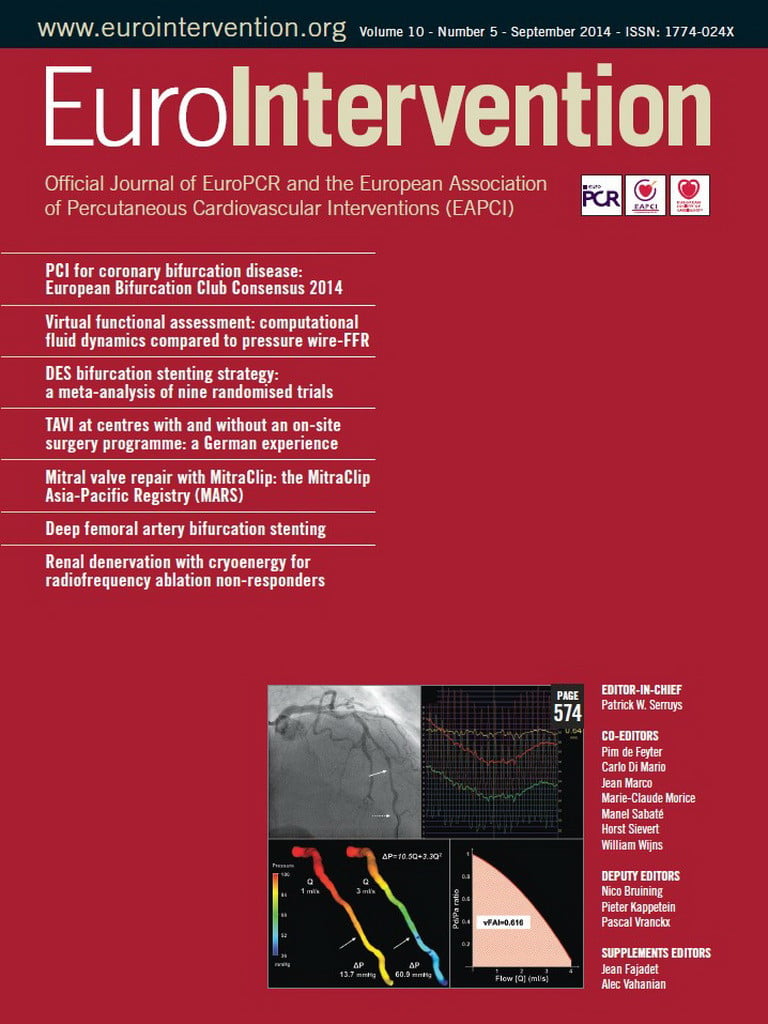Dear Editor,
I read with interest the article “Mechanical complications of everolimus-eluting stents associated with adverse events: an intravascular ultrasound study” by Inaba and colleagues1 which provides interesting information on stent fracture with a contemporary drug-eluting stent, and is complementary to the study recently published by Kuramitsu and colleagues2.
However, similarly to the Kuramitsu study, the term “everolimus-eluting stent” as used in this manuscript is misleading. Mechanical stent complications including stent recoil, stent fracture and longitudinal stent deformation (LSD) are not primarily related to the polymer or drug coating but to the underlying stent design. It appears that the authors examined solely the XIENCE V stent (Abbott Vascular, Santa Clara, CA, USA). This drug-eluting stent utilises the thin-strut cobalt-chromium MULTI-LINK VISION® (Abbott Vascular) bare metal platform, with three connectors between each ring and an in-phase peak to valley design. The XIENCE PRIME (Abbott Vascular), PROMUS Element™, Promus PREMIER™ and Synergy™ stents (Boston Scientific, Natick, MA, USA) are also all “everolimus-eluting stents” but possess different stent backbones from the MULTI-LINK VISION platform. For instance, the Element platform uses an alternative alloy (platinum chromium) and has only two connectors between each ring, which are aligned in an offset peak-peak formation. Changes in stent design result in different mechanical properties, as illustrated in recent bench studies showing variability in longitudinal strength between contemporary stent platforms, with the MULTI-LINK VISION demonstrating substantially greater longitudinal strength than the Element platform3. This appears to be clinically relevant with regard to LSD4,5.
However, given the enhanced flexibility of the Element platform (PROMUS Element), the stent fracture rate is likely to be lower than with the MULTI-LINK VISION stent (XIENCE V). Recently presented bench testing data from Professor Ormiston’s group support this theory6. The results of the current study therefore only apply to XIENCE V (and MULTI-LINK VISION) stents and not to all “everolimus-eluting stents”.
Another important point to emphasise is that “late” LSD, which was demonstrated in this study secondary to stent fracture, is a very different phenomenon from “acute” LSD which occurs at the time of stent implant due to extrinsic force applied to an already deployed stent.
This study highlights the clinical relevance of stent design, and operators should be aware of the unique characteristics of the stents they are using. Stents with strong longitudinal integrity may have a low risk of “acute” LSD but will also have reduced flexibility, and hence deliverability, which may in turn increase the risk of late stent fracture, and “late” LSD.
Conflict of interest statement
The author has no conflicts of interest to declare.
We thank Dr Williams for his interest and valuable comments1. We certainly agree that differences in stent design result in different propensities for device fracture, distortion, and failure2. The stents in our study were XIENCE V/Promus cobalt-chromium everolimus-eluting stents (CoCr-EES); none were PROMUS Element EES, and the results of our study apply solely to XIENCE V/Promus CoCr-EES. We agree this should have been clarified early in the manuscript.
Regarding acute vs. late acquired longitudinal stent deformation (LSD), of course we agree that these phenomena are very different in aetiology, and the mechanisms underlying each may be multifactorial. As we stated, very few patients had baseline procedural intravascular ultrasound (IVUS) imaging. Therefore, we cannot establish the frequency of acute LSD with XIENCE V/Promus CoCr-EES, although this was not observed angiographically in any case. Moreover, the decision to perform IVUS during clinically driven repeat angiographic procedures clearly indicates a high level of selection bias, and thus in no way are we implying that the mechanical complications described in our report are common. Rather, the purpose of our study was to describe that late strut fracture can lead to stent segment overlap, representing a novel cause of LSD that may be associated with reduction in lumen area, increased neointimal hyperplasia, and repeat revascularisation.
Finally, the propensity for strut fracture and LSD are only two of the numerous features that determine procedural and long-term success (or failure). Other factors which must be considered include, among others: device profile; deliverability; recoil; edge flaring; stent retention; strut width and thickness; characteristics of the delivery balloon (e.g., compliance, overhang); tip flexibility; metal to surface area and side branch access; polymer elasticity; robustness and reactivity; and drug-release kinetics, potency, and vascular toxicity. The balance of the trade-offs inherent in every stent design can only be assessed by the results of large-scale randomised trials with clinical endpoints. However, we believe that identification of specific failure modes, as in our study and that by Ormiston and colleagues2, may prompt design changes, resulting in iterative improvements and enhanced patient outcomes.
Conflict of interest statement
G. Mintz has received grant support and is a consultant to Boston Scientific Corporation. G. Stone is a consultant to Boston Scientific Corporation. A. Maehara has received grant support and is a consultant to Boston Scientific Corporation. S. Inaba has no conflicts of interest to declare.

